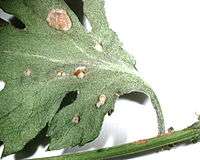Chrysanthemum white rust
| Chrysanthemum white rust | |
|---|---|
 | |
| Pustules caused by chrysanthemum white rust | |
| Scientific classification | |
| Kingdom: | Fungi |
| Phylum: | Basidiomycota |
| Class: | Urediniomycetes |
| Order: | Uredinales |
| Family: | Pucciniaceae |
| Genus: | Puccinia |
| Species: | P. horiana |
| Binomial name | |
| Puccinia horiana Henn. 1901 | |
Chrysanthemum white rust is a disease of plants caused by the fungus Puccinia horiana that infects species of the genus Chrysanthemum.
Origin and Spread
Chrysanthemum white rust was first identified in Japan, although it is now established throughout Asia, Europe, South America.[1] It has been found in the United States, Australia, and New Zealand on several occasions, but early detection and eradication efforts have prevented the disease from becoming established in these countries.[2]
Symptoms
Plants infected by chrysanthemum white rust exhibit spots on the upper surfaces of leaves. These spots are initially pale-green to yellow in color and up to 5mm in diameter, but may turn brown as the tissue becomes necrotic. On the underside of the leaf, the spots develop into pink or white pustules that become prominent as the teliospores develop.[2]
See also
References
- ↑ Data Sheets on Quarantine Pests. European and Mediterranean Plant Protection Organization. Retrieved on 2008-11-21.
- 1 2 Invasive and Emerging Fungal Pathogens - Diagnostic Fact Sheets. Hernández, J.R. Systematic Mycology and Microbiology Laboratory, ARS, USDA. 2004. Retrieved on 2008-11-21.